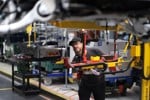Increased re-leasing or extending contracts may not be enough to ease the pain from the collapse in used battery electric vehicle (BEV) prices, new analysis suggests.
Having contributed to confidential reports on the future exposure to EV residual values (RVs) in the fleet and motor finance sectors, data experts at ADS say all players in the market, from leasing companies and their customers to manufacturers, are feeling the impact from the collapse in used prices for fully electric cars.
Fleet News has reported how pre-tax profits for the FN50 this year fell by almost a third (31.6%) year-on-year after hitting £2 billion for the first time in 2023.
Record-breaking used car prices driven by the semiconductor shortage, pushed FN50 reported pre-tax profits to a new high in 2023. However, the fall in BEV used values is massively impacting the financial performance of the UK’s 50 biggest vehicle leasing companies this year.
Collectively, the FN50 reported pre-tax profits of £1.39 billion – down £645 million on the £2.04bn achieved last year.
Used BEV values have fallen by 50% over the past two years.
Forecasting from Oxford Economics, published in September, suggested that used EV prices will carry on falling over the rest of this decade.
Between 2024 and 2030, it predicts used BEV prices to fall by a further 28%.
Some EVs, originally forecast to retain over 40% of their list price after three years, are achieving sale values in the 20% range.
On a car with a new list price of £40,000, that’s an unexpected loss of more than £7,000.
ADS says that the fundamental mismatch between market forces for new and used BEVs is at the heart of the crisis, as volume growth in new electric cars is driven by tax incentives, through company car and salary sacrifice schemes, without a corresponding increase in used vehicle demand.
It suggests that extending contracts and re-leasing EVs to mitigate loses, however, could negatively affect new BEV registrations in the fleet sector and impact manufacturers' ability to meet Government-imposed targets.
For employees, meanwhile, the value of their vehicle ‘perk’ is also diminished, as they are left driving older vehicles for longer instead of upgrading to a new EV.
“This is not about anti-EV sentiment and it’s clear that the leasing sector is fully behind the transition to zero-carbon driving,” said Amanda Morgan, commercial director and leasing sector lead at ADS, “but the pace of EV success has created an imbalance between the demands of the new and used car markets.”
“We are seeing recent analysis conducted across the fleet and finance sectors which indicates no end in sight for the EV residual values crisis and companies investigating ways to best postpone exposure to the used market,” she added.
“That means extending existing contracts wherever possible, to maintain revenue, and also re-leasing ex-contract vehicles rather than send them back into the market.”
The leasing industry to explore ways to generate as much revenue as possible from existing assets through lease extensions or offering used EV leasing as a service.
For example, Tusker recently launched a used EV salary sacrifice scheme, while Zenith has launched a lease extension programme called Project Volt, with almost 1,500 BEVs formally extended since the inception of the programme.
ADS says that manufacturers will be affected by any reduction in demand for new products due to lease extensions.
Historically, OEMs used the daily rental sector to offload excess vehicles during periods of weaker demand, but EVs are widely seen as unsuitable for that role.
ADS suggests that they may have to re-examine list prices which are widely seen as a barrier to adoption in new and used markets.
Morgan said: “We are already seeing more companies re-leasing ex-contract EVs, which provides the double benefit of not contributing to oversupply while also providing a more affordable EV leasing option for consumers taking their first step into the market.
“The only certainty in the current situation is that obtaining risk-related data from as many sources and perspectives as possible is more important than ever to avoid future shocks.”





















Login to comment
Comments
No comments have been made yet.